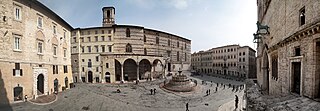
Perugia is the capital city of Umbria in central Italy, crossed by the River Tiber, and of the province of Perugia. The city is located about 164 km (102 mi) north of Rome and 148 km (92 mi) southeast of Florence. It covers a high hilltop and part of the valleys around the area. The region of Umbria is bordered by Tuscany, Lazio, and Marche.

Condottieri were Italian captains in command of mercenary companies during the Middle Ages and of multinational armies during the early modern period. They notably served popes and other European monarchs during the Italian Wars of the Renaissance and the European Wars of Religion. Notable condottieri include Prospero Colonna, Giovanni dalle Bande Nere, Cesare Borgia, the Marquis of Pescara, Andrea Doria, and the Duke of Parma.

Braccio da Montone, born Andrea Fortebraccio, was an Italian condottiero.

The House of Malatesta was an Italian family that ruled over Rimini from 1295 until 1500, as well as other lands and towns in Romagna and holding high positions in the government of cities in present day Tuscany, Lombardy and Marche. The dynasty is considered among the most important and influential of the Late Middle Ages. In the period of maximum influence, they extended their domains along the Marche coast, up to Ascoli Piceno, Senigallia, Sansepolcro and Citerna, and to the north, on the territories of Bergamo and Brescia.

Sigillo is a comune (municipality) in the province of Perugia in the Italian region Umbria, located about 35 km northeast of Perugia.
Carlo I Malatesta was an Italian condottiero during the Wars in Lombardy and lord of Rimini, Fano, Cesena and Pesaro. He was a member of the powerful House of Malatesta. Carlo's wife was Elisabetta Gonzaga; they were married in November 1386. Francesco I Gonzaga married Carlo's sister Margherita Malatesta in 1393, cementing ties between the families. Carlo was the brother of Pandolfo III and Andrea Malatesta, with whom he fought in numerous occasions.

Niccolò III d'Este was Marquess of Ferrara from 1393 until his death. He was also a condottiero.
Gian Paolo Baglioni was an Italian condottiero and lord of Perugia.
RidolfoII da Varano, signore di Camerino, was a condottiero operating in Italy from the 1360s. His forebears had long held the rocca of Varano on the borderland of the Papal States, controlling a major strategic pass between Umbria and the Marche, a link between Rome and the Adriatic coast. He inherited from Gentile di Berardo da Varano in 1355, and undertook the improvement of the fortifications that protected the commune and its rocca.

The de Roquefeuil-Blanquefort family previously named de Blanquefort is a French noble family from Aquitaine and Rouergue whose proven filiation began in 1393 when Jean of Blanquefort married Catherine de Roquefeuil-Anduze. Their son Antoine took his mother's name. The Roquefeuil-Blanquefort family gave several branches. The remaining two branches are Roquefeuil Monpeyroux and Roquefeuil Cahuzac. The Roquefeuil-Blanquefort family is a member of the Society of the Cincinnati.
Astorre Baglioni was an Italian condottiero and military commander.

Fra' Alessandro Ponziano Borgia was the leader of the Sovereign Military Order of Malta as Lieutenant of the Grand Master from 1865 to 1872.

Fulvio Giulio della Corgna was a Tuscan Catholic bishop and cardinal.
The following is a timeline of the history of the city of Perugia in the Umbria region of Italy.

Orazio di Giampaolo Baglioni was an Italian lord and condottiero. He took over command of Giovanni de' Medici's Black Bands after his death in 1526. Pope Clement VII held him responsible for the unrest in Perugia and imprisoned him in Castel Sant'Angelo in Rome. However, during the siege of Rome in 1527 prior to its sack, Clement put Orazio in charge of the city's defences. He died in an ambush during the Siege of Naples.

Escape to the Chateau is a Channel 4 reality television series which follows the story of couple Dick Strawbridge and Angel Adoree along with their family as they buy and renovate the 19th-century Château de la Motte-Husson in Martigné-sur-Mayenne, France, while simultaneously raising two young children and starting a business hosting weddings and other events.

The Château de la Motte-Husson is a Neo-Renaissance style château. It is located in the small market town of Martigné-sur-Mayenne, in the Mayenne département of France. The château is currently owned by Dick Strawbridge and his wife Angel. It is the setting for the Channel 4 programme Escape to the Chateau.

Count Rodolphe-Auguste Louis Maurice d'Ornano was a French aristocrat and politician during the Second French Empire.
Paul Marie Stanislas Honoré d'Albert de Luynes, 10th Duke of Chaulnes and Picquigny was a French aristocrat, soldier and writer.














